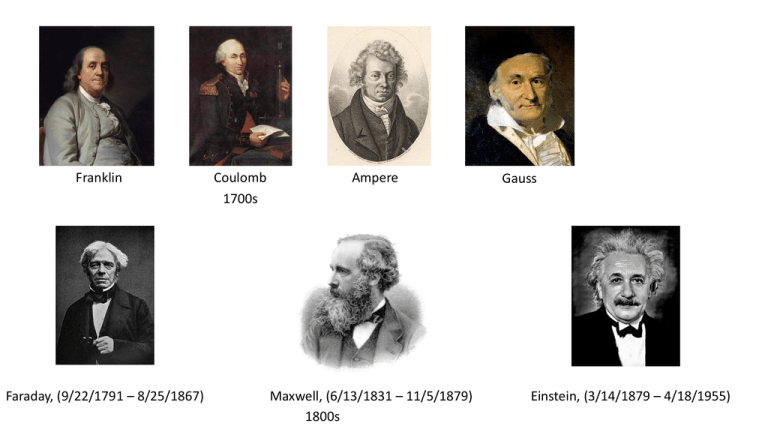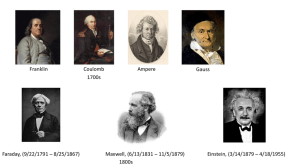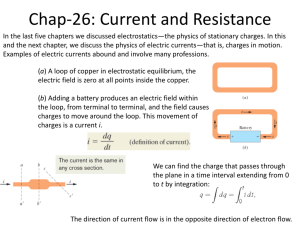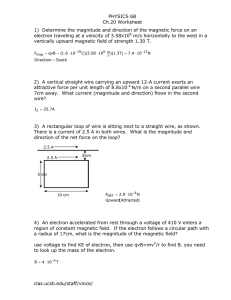Coulomb Ampere Franklin Gauss
advertisement

Franklin Faraday, (9/22/1791 – 8/25/1867) Coulomb 1700s Ampere Maxwell, (6/13/1831 – 11/5/1879) 1800s Gauss Einstein, (3/14/1879 – 4/18/1955) ~ 2010 (1012 transistors) ~ 1910 Electric field and temperature distributions Laplace equation ~ 1950 (capacity ~ 1 MB) ~ 2000 (capacity ~ 106 MB) ~ 2010 (capacity ~ 105 MB) Magnetic fields in matter, B and H fields “The connection between light and electricity is now established . . . In every flame, in every luminous particle, we see an electrical process . . . Thus, the domain of electricity extends over the whole of nature. It even affects ourselves intimately: we perceive that we possess . . . an electrical organ—the eye.” 𝐸⇔𝐵 Faraday, (9/22/1791 – 8/25/1867) Maxwell, (6/13/1831 – 11/5/1879) 1 𝑐= 𝜇0 𝜖0 Einstein, (3/14/1879 – 4/18/1955) q0 (test charge) r Although it looks thick, the cross section radius of the wire is very small compared to r 𝑖 Neutral current carrying conductor Rest frame S (the lab frame in which the positive ions of the wire are at rest) Magnetic field due to the current 𝜇0 𝑖 𝐵= 2𝜋𝑟 q0 B r 𝑖 Neutral current carrying conductor Rest frame S q0 B Just for convenience separate the negative charges and positive charges. They are still the same wire. 𝑖 Neutral current carrying conductor Neutral no electric field no electrostatic force 𝐹𝐵 = 𝑞0 𝑣 × 𝐵 no magnetic force Rest frame S B q0 −𝑞, 𝐿− 𝑞, 𝐿+ In this frame the charge q0 moves to the right with speed 𝒗𝑫 and the positive ions move to the right with the same speed giving rise to the same current i (same magnitude and direction as the rest Neutral no electric field no electrostatic force frame S) and hence the same magnetic field B. So 𝐹𝐵 points downwards. This 𝐹𝐵 = 𝑞0 𝑣𝐷 × 𝐵 There is a magnetic force conclusion contradicts observations which show that the charge q0 should just move to right and not move towards the wire. Moving frame S’ (a frame moving to the left at the same speed 𝒗𝑫 as the negative charges) B q0 −𝑞, 𝐿− 𝑞, 𝐿+ Relativity resolves this apparent paradox. First think of the moving charges as embedded in a rod with the rod moving with the same speed as the charges Neutral no electric field no electrostatic force 𝐹𝐵 = 𝑞0 𝑣𝐷 × 𝐵 There is a magnetic force Moving frame S’ q0 B −𝑞, 𝐿− 𝑞, 𝐿+ In the rest frame, the wire is neutral. ⇒ 𝜆+ = 𝜆− . Hence, if we choose the same amount of negative (−𝑞) and positive (+𝑞) charge then: 𝐿+ = 𝐿− In the frame S, the negatively charged rod is moving, so the length we observe is contracted from its proper length 𝐿−0 𝐿− = 𝐿−0 𝑣𝐷2 1− 2 𝑐 (1) 𝐿+ on the other hand is the proper length of the positively charged rod since it is at rest in the frame S. ⇒ 𝐿− = 𝐿−0 𝑣𝐷2 1 − 2 = 𝐿+ 𝑐 Rest frame S (2) B q0 −𝑞, 𝐿′− 𝑞, 𝐿′+ In the moving frame S’ we observe the proper length of the negatively charged rod since it is at rest now. 𝐿′− = 𝐿−0 The positively charged rod contracts in this frame. Since 𝐿+ is its proper length we have: 𝐿′+ = 𝐿+ 2 𝑣𝐷2 𝑣 𝐷 1 − 2 = 𝐿−0 1 − 2 𝑐 𝑐 Moving frame S’ (3) [Using (2)] Since charge is conserved we now have, 𝜆′+ > 𝜆′− . Hence, the wire is not neutral in the moving frame and there is an electric field. We will now calculate the electric field. −𝑞, 𝐿′− q0 B −𝑞, 𝐿− 𝑞, 𝐿′+ 𝜆′ 1 1 𝑞 𝑞 𝑞 1 1 𝑞 ′ ′ 𝐸= = 𝜆 + 𝜆− = − = − = 2𝜋𝜖0 𝑟 2𝜋𝜖0 𝑟 + 2𝜋𝜖0 𝑟 𝐿′+ 𝐿′− 2𝜋𝜖0 𝑟 𝐿′+ 𝐿′− 2𝜋𝜖0 𝑟 𝑞𝑞0 ⇒ 𝐹𝐸 = 2𝜋𝜖0 𝑟𝐿−0 1 𝑣𝐷2 1− 2 𝑐 𝑞𝑞0 −1 = 2𝜋𝜖0 𝑟𝐿−0 1 Here we used: 𝑐 = 𝜇0 𝜖0 𝑣𝐷2 𝑐2 𝑣𝐷2 1− 2 𝑐 𝑞𝑞0 = 2𝜋𝜖0 𝑟𝐿−0 1 𝐿−0 𝑣𝐷2 1− 2 𝑐 𝑣𝐷2 𝜇0 𝜖0 𝑣𝐷2 1− 2 𝑐 1 − − 𝐿0 𝑞𝑞0 = 2𝜋𝑟𝐿−0 (4) [Using (3)] 𝑣𝐷2 𝜇0 𝑣𝐷2 1− 2 𝑐 𝐹𝐸 points away from the wire since the positive charge density is higher Moving frame S’ B −𝑞, 𝐿′− q0 −𝑞, 𝐿− 𝑞, 𝐿′+ 𝑞𝑞0 ⇒ 𝐹𝐸 = 2𝜋𝑟𝐿−0 𝑣𝐷2 𝜇0 1− 𝑣𝐷2 𝑐2 𝐹𝐸 exactly cancels out the magnetic force in the moving frame. We will show that by calculating the magnetic force. Moving frame S’ (5) B −𝑞, 𝐿′− q0 −𝑞, 𝐿− 𝑞, 𝐿′+ Current due to negative charges = 0 𝑁 Current density due to positive charges: 𝑗 ′ = 𝑛𝑒𝑣𝐷 = ′ 𝑒𝑣𝐷 𝐴𝐿+ 𝑁 𝑞𝑣𝐷 ′ = 𝑗′𝐴 = 𝑖 𝑒𝑣 = Current due to positive charges: 𝐿′+ 𝐷 𝐿′+ n = number of charges per unit volume, N = total number of charges , A = cross section area of the wire 𝜇0 𝑖 ′ 𝜇0 𝑞𝑣𝐷 ⇒𝐵= = 2𝜋𝑟 2𝜋𝑟 𝐿′+ 𝜇0 𝑞𝑞0 𝑣𝐷2 𝜇0 ⇒ 𝐹𝐵 = 𝑞0 𝑣𝐷 𝐵 = = 2𝜋𝑟 𝐿′+ 2𝜋𝑟 (6) 𝑞𝑞0 𝑣𝐷2 𝐿−0 1 − 𝑣𝐷2 𝑐2 = 𝐹𝐸 Moving frame S’ B −𝑞, 𝐿′− q0 −𝑞, 𝐿− 𝑞, 𝐿′+ 𝜇0 𝑞𝑞0 𝑣𝐷2 𝜇0 ⇒ 𝐹𝐵 = 𝑞0 𝑣𝐷 𝐵 = = 2𝜋𝑟 𝐿′+ 2𝜋𝑟 𝑞𝑞0 𝑣𝐷2 𝐿−0 𝑣𝐷2 1− 2 𝑐 = 𝐹𝐸 𝐹𝐵 points towards the wire and exactly cancels out 𝐹𝐸 . Hence in both frames S and S’ there is no force in the vertical direction on the charge 𝑞0 consistent with observations. Moving frame S’ z 𝐴 y z 𝜃 𝐴 y






